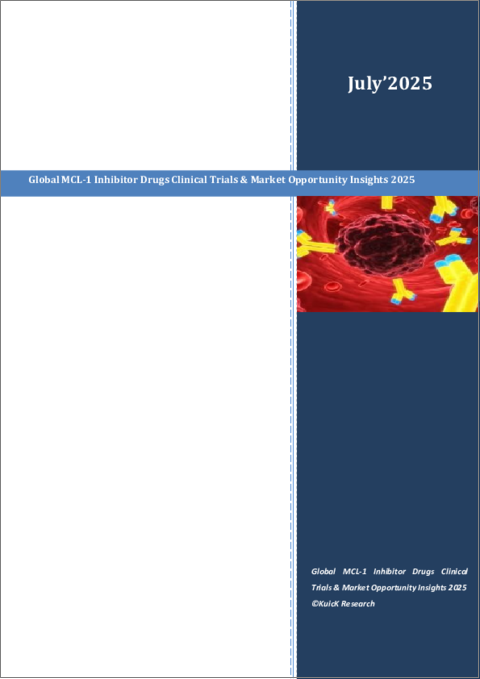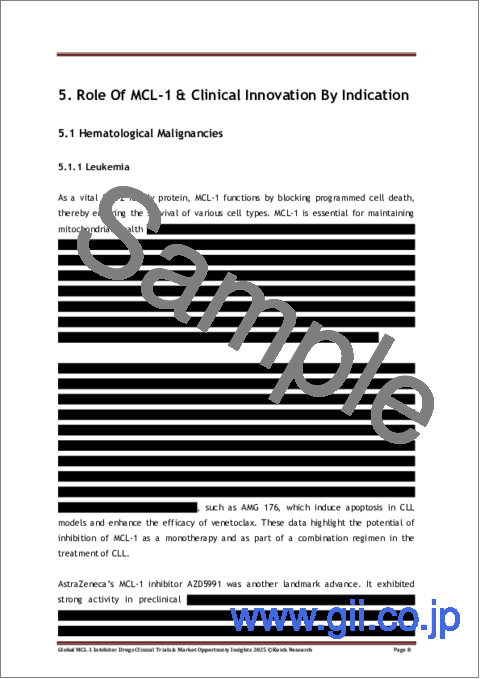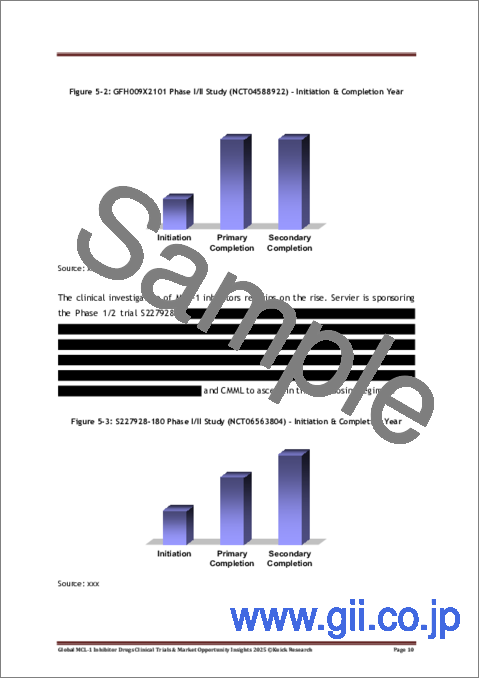|
|
市場調査レポート
商品コード
1771778
MCL1阻害薬の世界市場:臨床試験と市場機会(2025年)Global MCL1 Inhibitor Drugs Clinical Trials & Market Opportunity Insights 2025 |
||||||
|
|||||||
| MCL1阻害薬の世界市場:臨床試験と市場機会(2025年) |
|
出版日: 2025年07月01日
発行: KuicK Research
ページ情報: 英文 80 Pages
納期: 即日から翌営業日
|
全表示
- 概要
- 図表
- 目次
MCL1阻害薬の世界市場:臨床試験と市場機会(2025年)レポートハイライト:
- 調査手法
- 世界のMCL-1標的治療薬市場の機会展望
- 臨床試験中のML1阻害薬:>12品目
- MCL-1の役割と適応症別の臨床イノベーション
- MCL-1標的療法の臨床試験インサイト:企業別、国別、適応症別、相別
- MCL-1標的アプローチ
- 競合情勢
MCL-1は、新規がん治療の追求において最も興味深い分子標的の一つとして浮上しています。BCL-2ファミリーに属する強力な抗アポトーシス蛋白質であるMCL-1は、特にAMLやリンパ腫のような侵攻性の血液悪性腫瘍において、がん細胞の生存を維持する上で極めて重要です。MCL-1を標的とする科学的論理は否定できませんが、コンセプトから臨床への道のりは、主に心臓に関連する安全性の問題によって厳しい課題に直面し、進歩が頓挫したり、投資家の楽観的な見通しが妨げられたりしてきました。
過去10年の間に、非常に有効なMCL-1阻害剤の多くが初期段階の臨床試験に進み、その多くが抗腫瘍活性を示し始めました。しかし、いくつかの候補薬に再現性のある心毒性が現れたため、熱意は冷めました。心臓がミトコンドリアの完全性を維持するためにMCL-1に依存していることは、基本的な脆弱性のようです。阻害は臓器のエネルギー代謝と細胞ストレス適応を破壊し、バイオマーカーの増加や組織学的な心臓障害など、不安な安全性シグナルを作り出します。
この懸念は、製薬会社をより創造的なものへと駆り立てた。標準的な方法ではなく、新薬は心臓への長時間曝露を減らすために半減期が非常に短くなるように作られています。薬物動態を最適化することで、がん細胞を強力に攻撃することが可能になるが、その時間は一瞬であり、理論的には敏感な組織を保護することができます。パルス投与も研究されている方法のひとつで、薬物曝露の間に身体が回復する時間を与えます。
一方、MCL-1を間接的に標的とするアプローチも広まっています。CDK9のようなMCL-1の転写を制御するサイクリン依存性キナーゼを阻害することで、科学者たちは実際にタンパク質に結合することなくMCL-1のレベルを下げようとしています。このような薬剤は通常、他の治療法と併用され、臨床試験が行われています。このような薬剤にも血液毒性などの副作用があるが、作用機序が異なるため、より忍容性が高いことが期待されます。
同時に、次世代の治療ツールも進歩しています。PROTACsのようなタンパク質分解アプローチは、MCL-1を単独で阻害するのではなく、選択的に分解する可能性という新たな機会をもたらしました。現在前臨床段階にあるこの戦略により、どの組織を標的とするか、より微妙なコントロールが可能になるかもしれないです。同様に、安定化ペプチドや金属含有化合物のような他の技術も、創薬に役立つ新しい分子足場を提供しています。
MCL-1阻害剤の商業的可能性は、おそらくこれらの研究戦略が精密医療にどれだけ適合するかにかかっています。BH3プロファイリングのような治療は、腫瘍が生き残るためのMCL-1への依存度を定量化するもので、適切な治療を受ける患者を特定するために応用されています。分子アッセイや機能アッセイに基づいてMCL-1依存性腫瘍を事前に選択できるようになれば、臨床試験の成功率が大幅に向上し、標的治療が容易になる可能性があります。現在のところ、有効なバイオマーカーがないことが大きなギャップですが、現在進行中の研究がその方向に向かっています。
併用治療は、もう一つの潜在的な商機です。ブロックバスター的な単剤治療を求めるのではなく、MCL-1阻害剤は個別化された治療レジメンの構成要素として確立されるかもしれません。他のアポトーシス経路促進薬、免疫療法、あるいは化学療法と組み合わせることで、より安全な低用量でより高い効果が得られる可能性があります。数理モデルやシミュレーション・プラットフォームも、こうした併用療法を情報提供するために応用されており、承認までの道のりを短縮できる可能性があります。
初期開発のほとんどは欧州と北米で行われてきましたが、中国、日本、南米などの新興国市場でも関心が高まっています。これらの市場には多様な患者集団が存在するだけでなく、商業化や臨床試験の新たな道も開かれています。戦略的提携や地域開発計画により、開発期間が短縮され、将来的な入手可能性が拡大する可能性があります。
結局のところ、MCL-1阻害剤市場は、一方では明確な治療ニーズがあり、他方では大きな安全性の壁があるというパラドックスによって定義される市場です。今日までに達成された進歩は、不十分ではあるが、薬理学的、ゲノム学的、計算学的情報を組み合わせるという、よりスマートな医薬品開発の方向への動きを示しています。MCL-1療法が初めて承認される日はそう遠くないかもしれません。産学が精密なツールと合理的なデザインによってリスクを回避することができれば、これらの阻害剤は、治療の選択肢が限られている患者にとって、画期的な選択肢を提供することができると思われます。
当レポートは、世界のMCL1阻害薬市場について調査し、市場の概要とともに、薬剤動向、臨床試験動向、地域別動向、および市場に参入する企業の競合情勢などを提供しています。
目次
第1章 調査手法
第2章 MCL-1標的療法のイントロダクション
- 治療標的としてのMCL-1
- MCL-1の腫瘍学的意義
第3章 MCL-1標的アプローチ
- 低分子
- ペプチド
- 天然物由来の阻害剤
- PROTAC
- アンチセンスオリゴヌクレオチド
第4章 世界のMCL-1標的療法市場の機会見通し
- 現在の臨床調査の情勢
- 将来の商業化の機会
第5章 MCL-1の役割と適応症別の臨床イノベーション
- 造血悪性腫瘍
- 白血病
- リンパ腫
- 多発性骨髄腫
- 固形がん
- 肺がん
- 乳がん
- 黒色腫
- 大腸がん
- 微生物感染症
第6章 MCL-1標的療法の臨床試験の概要
- 企業別
- 国別
- 適応症別
- 患者セグメント別
- 相別
第7章 MCL-1標的療法の臨床試験:企業、国、適応症、相別
- 研究
- 前臨床
- 第I相
- 第I/II相
- 第II相
第8章 競合情勢
- Broad Institute
- Captor Therapeutics
- Gilead Sciences
- Servier
- Sirnaomics
List of Figures
- Figure 2-1: MCL-1 Dysregulation In Cancer
- Figure 2-2: MCL-1 Related Therapeutics - Future Directions
- Figure 2-3: Apoptotic Balance In Healthy vs. Cancer Cells
- Figure 2-4: MCL-1 - Oncogenic Functions
- Figure 2-5: MCL-1 - From Discovery to Drug Development
- Figure 3-1: Small Molecules Targeting MCL-1 - Mechanisms of Direct vs. Indirect Inhibition
- Figure 3-2: MCL-1 Targeting - Macrocyclic Peptides vs. Linear Peptides
- Figure 3-3: MCL-1 PROTACs - Mechanism of Action
- Figure 3-5: MCL-1 Antisense Oligonucleotides - Mechanism Of Action
- Figure 4 1: MCL-1 Targeting Therapy Market - Future Opportunities
- Figure 5-1: BAML-16-001 Phase I/II Study (NCT03013998) - Initiation & Completion Year
- Figure 5-2: GFH009X2101 Phase I/II Study (NCT04588922) - Initiation & Completion Year
- Figure 5-3: S227928-180 Phase I/II Study (NCT06563804) - Initiation & Completion Year
- Figure 5-4: SZAML06 Phase III Study (NCT06532552) - Initiation & Completion Year
- Figure 6-1: Global - MCL-1 Inhibitor Drugs Trials By Company (Numbers), 2025
- Figure 6-2: Global - MCL-1 Inhibitor Drugs Trials By Country (Numbers), 2025
- Figure 6-3: Global - MCL-1 Inhibitor Drugs Trials By Indication (Numbers), 2025
- Figure 6-4: Global - MCL-1 Inhibitor Drugs Trials by Patient Segment (Numbers), 2025
- Figure 6-5: Global - MCL-1 Inhibitor Drugs Trials By Phase (Numbers), 2025
List of Tables
- Table 3-1: MCL-1 Targeting - PROTAC vs. Small Molecule Inhibitor
Global MCL1 Inhibitor Drugs Clinical Trials & Market Opportunity Insights 2025 Report Highlights:
- Research Methodology
- Global MCL-1 Targeting Therapy Market Opportunity Outlook
- ML1 Inhibitor Drug In Clinical Trials: > 12 Drugs
- Role Of MCL-1 & Clinical Innovation By Indication
- MCL-1 Targeting Therapies Clinical Trials Insight By Company, Country, Indication & Phase
- MCL-1 Targeting Approaches
- Competitive Landscape
MCL-1 has emerged as one of the most intriguing molecular targets in the pursuit of novel cancer treatments. A potent anti-apoptotic protein from the BCL-2 family, MCL-1 is crucial in keeping cancer cells alive, particularly in aggressive hematologic malignancies like AML and lymphomas. Although the scientific logic behind targeting MCL-1 is undeniable, the path from concept to clinic has faced severe challenges owing to primarily cardiac related safety issues that derailed progress and deterred investors from being optimistic.
Over the past decade, a number of highly efficacious MCL-1 inhibitors have progressed to early stage clinical trials, with many of them beginning to demonstrate antitumor activity. Enthusiasm was dampened, however, when reproducible cardiotoxicity emerged among several candidates. The heart's dependence on MCL-1 for the upkeep of mitochondrial integrity seems a fundamental vulnerability. Inhibition disrupts the organ's energy metabolism and cellular stress adaptation, creating unsettling safety signals that have included increased biomarkers and histologic cardiac damage.
This concern has spurred drug companies to become more creative. Rather than standard methods, newer drugs are being crafted to have very short half lives in order to reduce extended cardiac exposure. Pharmacokinetic optimization enables the medication to attack cancer cells with force but for an instant, theoretically protecting sensitive tissues. Pulsed dosing is another method being investigated, providing the body with time to recover between exposures to the drug.
While this is happening, other approaches to indirectly target MCL-1 are also becoming prevalent. By inhibiting the cyclin dependent kinases that regulate MCL-1 transcription, like CDK9, scientists are trying to tone down MCL-1 levels without actually binding to the protein. Such agents, which are usually combined with other therapies, are being clinically tested. While they also have side effects, for instance, blood related toxicities, their mode of action is different and gives promise to being more tolerable.
At the same time, a next generation of therapeutic tools is advancing. Protein degradation approaches such as PROTACs have unveiled a new opportunity, with the possibility of selective degradation of MCL-1 instead of inhibition alone. This strategy, currently preclinical, could enable more subtle control over which tissues are targeted. Likewise, other techniques, such as stabilized peptides and metal-containing compounds, are offering novel molecular scaffolds to aid in drug discovery.
The commercial potential of MCL-1 inhibitors will probably hinge on how well these research strategies fit with precision medicine. Practices such as BH3 profiling, which quantify a tumor's reliance on MCL-1 to survive, are being applied to identify patients for the appropriate treatment. Being able to pre select MCL-1-dependent tumors based on molecular or functional assays could significantly boost success with trials and facilitate targeted therapies. Currently, the absence of validated biomarkers is a major gap, but ongoing research is headed in that direction.
Combination treatments are another potential commercial opportunity. Instead of seeking blockbuster monotherapy, MCL-1 inhibitors might become established as components of personalized treatment regimens. Combination with other pro apoptotic pathway drugs, immunotherapies, or chemotherapies could enable greater efficacy at safer lower doses. Mathematical models and simulation platforms are also being applied to inform these combinations, which may reduce the route to approval.
Although most early development has occurred in Europe and North America, there is growing interest in developing markets such as China, Japan, and South Korea. These markets not only offer diverse populations of patients but also present new avenues for commercialization and clinical testing. Strategic alliances and regional development plans may shorten times and extend future availability.
At the end, the MCL-1 inhibitor market is one defined by paradox: a clear therapeutic need on one side and a major safety barrier on the other. The advances achieved to date, while inadequate, represent a movement in the direction of smarter drug development: combining pharmacologic, genomic, and computational information. The first approved MCL-1 therapy may not be far off. If industry and academia can navigate the risks with precision tools and rational design, these inhibitors could offer transformative options for patients with limited treatment choices.
Table of Contents
1. Research Methodology
2. Introduction To MCL-1 Targeting Therapies
- 2.1 MCL-1 As Therapeutic Target
- 2.2 Oncologic Implication Of MCL-1
3. MCL-1 Targeting Approaches
- 3.1 Small Molecules
- 3.1.1 Indirect Inhibition
- 3.1.2 Direct Inhibition
- 3.2 Peptides
- 3.3 Natural Product-Derived Inhibitors
- 3.4 PROTACs
- 3.5 Antisense Oligonucleotides
4. Global MCL-1 Targeting Therapy Market Opportunity Outlook
- 4.1 Current Clinical Research Landscape
- 4.2 Future Commercialization Opportunities
5. Role Of MCL-1 & Clinical Innovation By Indication
- 5.1 Hematological Malignancies
- 5.1.1 Leukemia
- 5.1.2 Lymphoma
- 5.1.3 Multiple Myeloma
- 5.2 Solid Cancers
- 5.2.1 Lung Cancer
- 5.2.2 Breast cancer
- 5.2.3 Melanoma
- 5.2.4 Colorectal cancer
- 5.3 Microbial Infections
6. Global MCL-1 Targeting Therapies Clinical Trials Overview
- 6.1 By Company
- 6.2 By Country
- 6.3 By Indication
- 6.4 By Patient Segment
- 6.5 By Phase
7. MCL-1 Targeting Therapies Clinical Trials Insight By Company, Country, Indication & Phase
- 7.1 Research
- 7.2 Preclinical
- 7.3 Phase I
- 7.4 Phase I/II
- 7.5 Phase II
8. Competitive Landscape
- 8.1 Broad Institute
- 8.2 Captor Therapeutics
- 8.3 Gilead Sciences
- 8.4 Servier
- 8.5 Sirnaomics





